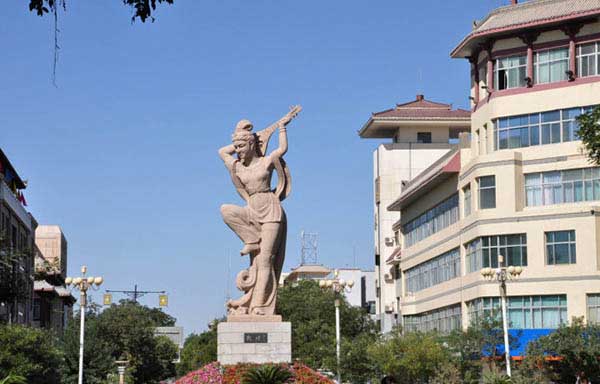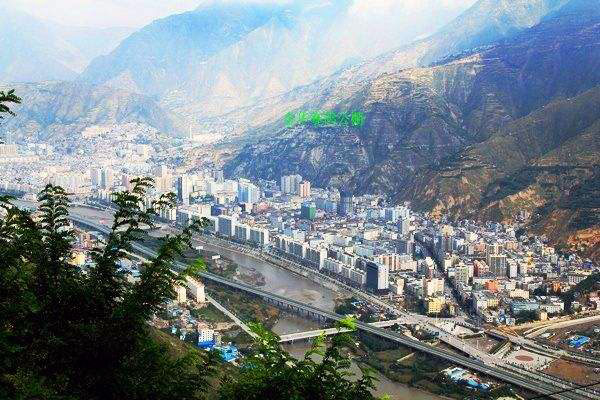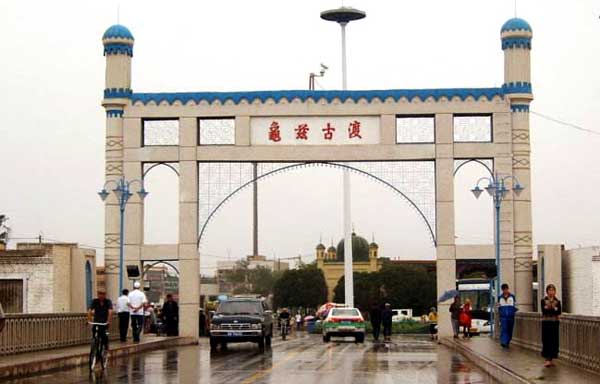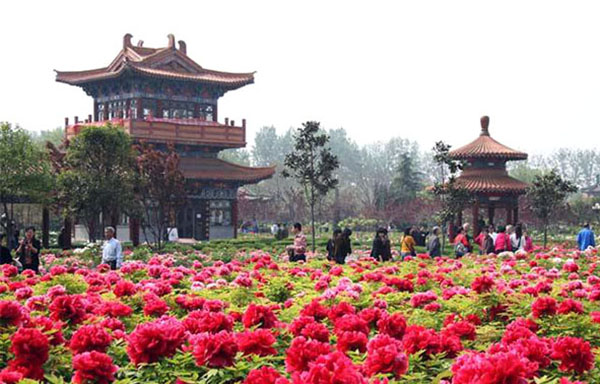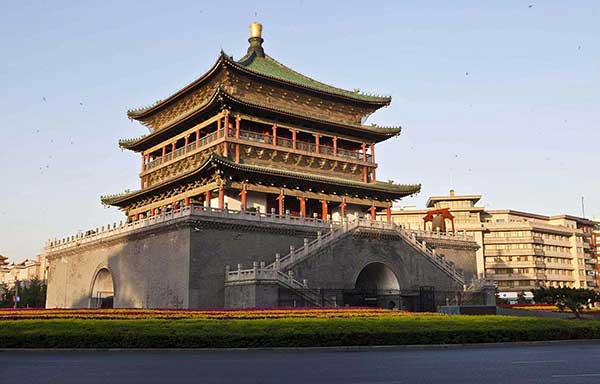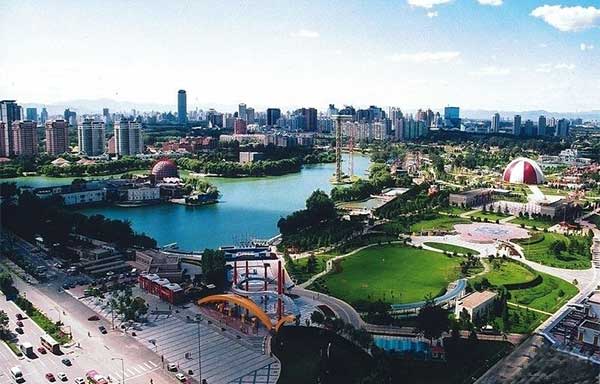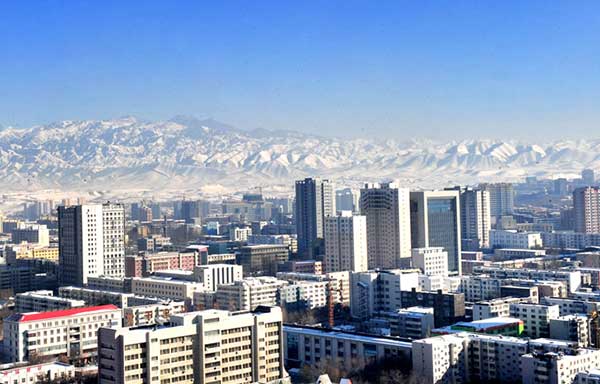- By admin
- In SilkRoadNews
- 2023-10-31
The documentary "Great Dunhuang" tells the story of exchanges and mutual learning between civilizations

Recently, the China Media Group released four episodes of large-scale cultural and historical documentary "Great Dunhuang" on the documentary channel.
The film focuses on Dunhuang culture, looking for civilization elements and cultural symbols by taking Dunhuang as a historical example, presenting and telling Dunhuang stories with a broad international perspective, authentic video records, and rich historical materials, exploring the logic of civilization operation, demonstrating the cultural confidence of the Chinese nation, and showing the achievements of exchanges between eastern and Western civilizations.
The documentary "Great Dunhuang" consists of 4 episodes. The first episode "Why Dunhuang", by examining the construction process of Dunhuang City, post stage system, Hexi Corridor guard system, as well as the westward spread of Confucianism and Taoism culture in the Central Plains and the establishment process of farming lifestyle, shows that only with the support of strong national strength can Dunhuang, a major Silk Road town, be raised, and lay a solid foundation for the dialogue, collision, exchange and integration of Eastern and Western civilizations in Dunhuang. The second episode of Dunhuang Code, through the exploration of the "three rabbits with ears" pattern, the evolution process of flying sky, the Dunhuang star map and other stories behind, to find the common cultural genes and cultural codes of eastern and western civilizations, indicating that the exploration and yearning for the starry world, life philosophy, aesthetic orientation is the common value pursuit of human beings. The third episode "Civilization Stage", through the Sogdian letters, Hu rotation dance, Dunhuang costumes, silk painting embroidery in the Buddhist cave, the first carved printed book, etc., shows an international cultural stage with prosperous culture, open mind, rich commodities, and fashion trends, indicating that the fate of our modern people is linked to the fate of the ancients, and also shows that the fate of the whole human society is closely related. The fourth episode, "Remaking Dunhuang", brings the time line back to the modern era, through the narration of Dunhuang music and dance reproduction, restoration and restoration of Dunhuang murals, cloning of Dunhuang grottoes, "digital Dunhuang", cultural relics return, etc., to continue the past, look at the present, and move toward the future, and show the protection and inheritance of Dunhuang culture today, as well as the inspiration of Dunhuang culture for the exchange and integration of today's civilizations.
The grand narrative structure of the documentary makes us feel for the superb professional level and creative attitude of the CCTV documentary production team, and we can not help but feel proud of Dunhuang, which was born under the Chinese civilization system, and Dunhuang culture with strong historical connotation, profound cultural connotation and beautiful artistic image. "Dunhuang culture, which has lasted for nearly 2,000 years, is the world's largest existing art treasure house, the longest duration, the richest content and the most complete preservation. It is a bright pearl in the long river of world civilization, and also a precious historical data for the study of the politics, economy, military, culture and art of various ethnic groups in ancient China." Dun, big also; Brilliant, Sheng also. Dunhuang: magnificent meaning. Dunhuang deserves this title, through history, we have to think about why history chose Dunhuang, and how Dunhuang can become its great.
One
From today's satellite map, Dunhuang is not an ideal place to build a city for agricultural civilization. The north and south are plateaus, the west is thousands of miles of yellow sand, and the east is thousands of miles away from Chang 'an, the center of Central Plains civilization. But at the same time, it has a very important strategic significance, was once the throat of the Hexi Corridor, can connect the western regions, back can protect the Central Plains. Therefore, when the Xiong Han Dynasty rose, Huo Qubing repelled the Xiongnu, and Zhang Qian "chiselled out" the Western regions, the Central Plains Dynasty decided to build a city here.
Dunhuang was born out of the strategic need of the Han Dynasty, but maintaining such a border town was difficult. Emperor Wudi of Han Dynasty, Li Guangli 180,000 troops stationed in Dunhuang, coupled with the long military fortifications to be built, given the natural conditions and the level of material production in Dunhuang at that time, it was impossible to afford this huge daily consumption, the needed grain, grass and materials had to be transported from the Central Plains, the distance of the road and the huge loss of land transportation, the required support was no less than astronomical. Without the strength of the Han Dynasty, it would have been unbearable. But relying on the Central Plains alone was not a long-term solution, so the Western Han Dynasty decided to build water conservancy here and garrison the border fields.
Since the Han Dynasty, the Central Plains dynasty has experienced several turbulents, but to the Tang Dynasty for more than 800 years, traveling to and from the East and west merchants, so that Dunhuang never fell. Until the Tang Dynasty, Dunhuang once again ushered in its highlight moment. As the most powerful dynasty in the world at that time, the Tang Dynasty provided all the necessary conditions for Dunhuang's prosperity. The charm of the Central Plains culture, the richness of the central Plains products, and the prosperity of the Central Plains civilization have made an endless flow of Western visitors. Their first stop in contact with the Tang Dynasty is Dunhuang, where different looks, different languages, and different costumes complement each other, jointly creating the prosperity of Dunhuang and creating a splendid Dunhuang culture.
Two
Since the day of its birth, Dunhuang has been a place of multi-ethnic exchanges and multi-cultural integration, which is rare in the long history of human history and the history of world civilization.
Ji Xianlin, a master of Chinese culture, once said, "There are only four cultural systems in the world with a long history, vast territory, self-established system and far-reaching influence: China, India, Greece and Islam, and there is no fifth; The only place where these four cultural systems converge is Dunhuang and Xinjiang in China, and there is no other place." For more than 2,000 years, Dunhuang, with its generous mind and peaceful and inclusive temperament, has allowed various civilizations to coexist, integrate and coexist here. Dunhuang provided a platform for the meeting of the four civilizations. Many Kings, protons, envoys and business travelers from the Western Regions entered Dunhuang through the Silk Road. They were treated fairly here like the local people, and their identities, languages, beliefs, habits and costumes were respected here. Taking clothing as an example, in the existing more than 45,000 square meters of murals and more than 2,000 colored sculptures in Dunhuang, there are imperial and general court clothing, ordinary People's Daily clothing, military clothing of border officers, exotic foreign clothing, etc. Dunhuang at that time was like a huge runway, and international fashion shows were staged here every day.
Three
When various cultures converged in Dunhuang, they realized the integration and development of each other. The reason is that as the mother culture of Dunhuang, Chinese civilization has a long history, deep roots and large leaves, and has outstanding continuity, innovation, unity, inclusiveness and peace.
Since the period of Wei, Jin, Southern and Northern Dynasties, the process of spreading Western learning to the east has never stopped for two thousand years, and Dunhuang is the first stop of this process. The flying sky in the murals of the Mogao Grottoes can best explain this phenomenon. The flying sky originated from India. In the early days of the Mogao Grottoes, the flying sky was a male figure with a short body, half-naked body, long skirt around the waist and a large scarf on the shoulders. Such integration is countless, including philosophical thoughts, cultural customs, food, daily living and other aspects, at the same time, Chinese culture from Dunhuang, to show the world the charm of China. The pattern of "three rabbits with one ear" is widely used in various buildings and artifacts. They first appeared in the Tiangong barrier wall of Cave 302 in the Mogao Grottoes, and appeared in the center of 17 cavern Wells in the Mogao Grottoes, and then along the Silk Road to the west. "Tao Te Ching" said "Tao born one, life two, two born three, three born all things", "Records of the Grand Historian" said "number begins with one, finally ten, into three", the Han Dynasty tile has three phoenix patterns, the Eastern Han sarcophagus has three fish with the same head, and so to the early Sui and Tang Dynasties, three rabbits jumped from Dunhuang, becoming the best example of Chinese culture affecting the world.
Looking back at the history, we find that when the culture of other regions merged into the Central Plains through Dunhuang, it greatly enriched the connotation of Chinese culture; When the culture of the Central Plains was introduced to the world through Dunhuang, it greatly enriched the cultural forms of the world. The splendid culture of Dunhuang is the integration of the cultural essence of all ethnic groups in the world, and it is also a model of continuous integration of Chinese civilization with a long history of thousands of years. It is precisely because the Chinese civilization has a strong source and roots of independence, a foundation of openness and inclusiveness, and a path of self-improvement that keeps pace with The Times and changes the past and the future that the Chinese nation has stood firm in the face of global cultural upheavals.
"Diversity leads civilizations to exchange, learn from each other through exchanges, and develop through mutual learning."
With the theme of promoting cultural exchanges and mutual learning of civilizations, as well as inheriting and carrying forward fine traditional Chinese culture, the documentary "Great Dunhuang" uses the perspective of Dunhuang to understand the world and reread Dunhuang from the perspective of the world.
0
Related destinations
Why Choose Us?
We are the top Silk Road tour operator based in Dunhuang, China. We focus on providing well designed Silk Road China Tours with resonable price and thoughtful service.
- Easy & carefree booking
- The best value
- Great travel experience
- Locally operated
Hot Tours
-

6 days Gansu tour to Binglingsi, Xiahe and Langmusi
Tour type : Private tour Price : from *** Destinations : Lanzhou - linxia - Xiahe - Langmusi - Hezuo - Lanzhou -

12 Days Gansu Highlights Tour
Tour type : Private tour Price : from *** Destinations : Xian – Tianshui – Lanzhou – Xiahe – Langmusi – Hezuo – Zhangye – Jiayuguan - Dunhuang -

10 Days Silk Road Classic Tour
Tour type : Private tour Price : from *** Destinations : Xian - Zhangye - Jiayuguan - Dunhuang - Turpan - Urumqi -

5 Days Zhangye - Alxa youqi Highlights Tour
Tour type : Private Tour Price : from *** Destinations : Zhangye - Alax youqi - Zhangye

